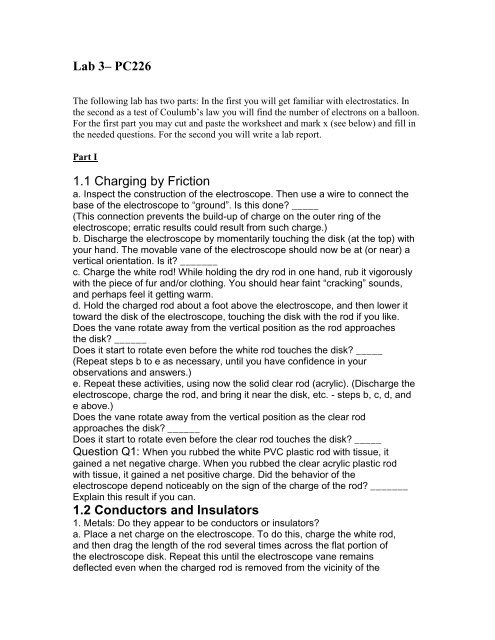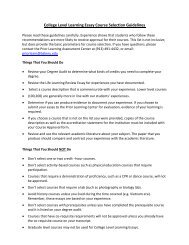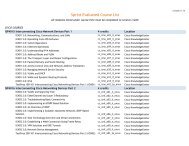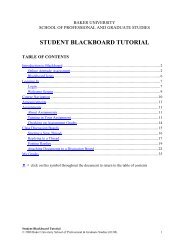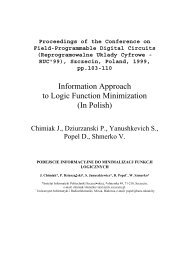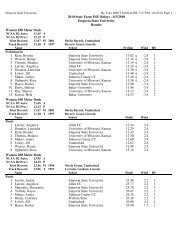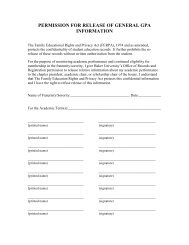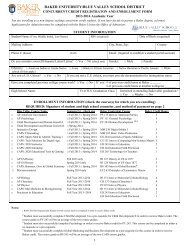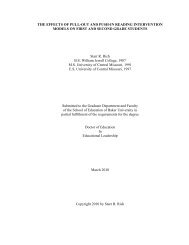Lab 3â PC226 1.1 Charging by Friction 1.2 Conductors and Insulators
Lab 3â PC226 1.1 Charging by Friction 1.2 Conductors and Insulators
Lab 3â PC226 1.1 Charging by Friction 1.2 Conductors and Insulators
- No tags were found...
You also want an ePaper? Increase the reach of your titles
YUMPU automatically turns print PDFs into web optimized ePapers that Google loves.
<strong>Lab</strong> 3– <strong>PC226</strong><br />
The following lab has two parts: In the first you will get familiar with electrostatics. In<br />
the second as a test of Coulumb’s law you will find the number of electrons on a balloon.<br />
For the first part you may cut <strong>and</strong> paste the worksheet <strong>and</strong> mark x (see below) <strong>and</strong> fill in<br />
the needed questions. For the second you will write a lab report.<br />
Part I<br />
<strong>1.1</strong> <strong>Charging</strong> <strong>by</strong> <strong>Friction</strong><br />
a. Inspect the construction of the electroscope. Then use a wire to connect the<br />
base of the electroscope to “ground”. Is this done _____<br />
(This connection prevents the build-up of charge on the outer ring of the<br />
electroscope; erratic results could result from such charge.)<br />
b. Discharge the electroscope <strong>by</strong> momentarily touching the disk (at the top) with<br />
your h<strong>and</strong>. The movable vane of the electroscope should now be at (or near) a<br />
vertical orientation. Is it _______<br />
c. Charge the white rod! While holding the dry rod in one h<strong>and</strong>, rub it vigorously<br />
with the piece of fur <strong>and</strong>/or clothing. You should hear faint “cracking” sounds,<br />
<strong>and</strong> perhaps feel it getting warm.<br />
d. Hold the charged rod about a foot above the electroscope, <strong>and</strong> then lower it<br />
toward the disk of the electroscope, touching the disk with the rod if you like.<br />
Does the vane rotate away from the vertical position as the rod approaches<br />
the disk ______<br />
Does it start to rotate even before the white rod touches the disk _____<br />
(Repeat steps b to e as necessary, until you have confidence in your<br />
observations <strong>and</strong> answers.)<br />
e. Repeat these activities, using now the solid clear rod (acrylic). (Discharge the<br />
electroscope, charge the rod, <strong>and</strong> bring it near the disk, etc. - steps b, c, d, <strong>and</strong><br />
e above.)<br />
Does the vane rotate away from the vertical position as the clear rod<br />
approaches the disk ______<br />
Does it start to rotate even before the clear rod touches the disk _____<br />
Question Q1: When you rubbed the white PVC plastic rod with tissue, it<br />
gained a net negative charge. When you rubbed the clear acrylic plastic rod<br />
with tissue, it gained a net positive charge. Did the behavior of the<br />
electroscope depend noticeably on the sign of the charge of the rod _______<br />
Explain this result if you can.<br />
<strong>1.2</strong> <strong>Conductors</strong> <strong>and</strong> <strong>Insulators</strong><br />
1. Metals: Do they appear to be conductors or insulators<br />
a. Place a net charge on the electroscope. To do this, charge the white rod,<br />
<strong>and</strong> then drag the length of the rod several times across the flat portion of<br />
the electroscope disk. Repeat this until the electroscope vane remains<br />
deflected even when the charged rod is removed from the vicinity of the
electroscope. Is the electroscope now charged ______<br />
How can you tell ____________________________________________<br />
b. Holding an aluminum rod in your h<strong>and</strong>, touch the rod momentarily to the<br />
disk at the top of the “charged” electroscope.<br />
Describe what happened. ______________________________________<br />
c. Repeat steps a <strong>and</strong> b if necessary until you have confidence in your<br />
observations <strong>and</strong> statements above.<br />
Your conclusions: Does the aluminum rod appear to be a conductor of<br />
electric charge, or an insulator __________________ Justify your<br />
conclusion:<br />
d. An ordinary lab wire consists of a core of copper str<strong>and</strong>s with an outer<br />
covering of plastic. Each end of the copper core is connected to metal<br />
plugs.<br />
Repeat the process above (steps a, b, <strong>and</strong> c), using now an ordinary lab<br />
wire instead of the aluminum rod. With one h<strong>and</strong>, hold the bare metal plug<br />
at one end of the wire. Then with your other h<strong>and</strong> holding the plastic cover<br />
of the wire, bring the other bare metal plug into contact with the disk of the<br />
charged electroscope.<br />
Repeat these steps until you have confidence in your observations.<br />
Does the length of lab wire act as a conductor of electric charge, or as an<br />
insulator __________________ Justify your conclusion:<br />
2. Plastics: Do they appear to be conductors or insulators<br />
a. Again, place a net charge on the electroscope (as you did in part 1-a<br />
above).<br />
b. Holding any available plastic rod in your h<strong>and</strong>, touch the rod momentarily to<br />
the disk at the top of the “charged” electroscope, <strong>and</strong> then remove it.<br />
c. Did the electroscope discharge (as it did when you touched the<br />
electroscope with the aluminum rod) _____<br />
Repeat these steps until you have confidence in your observations.<br />
Your conclusions: Does the plastic rod appear to be a conductor of electric<br />
charge, or an insulator __________________ Justify your conclusion:<br />
_<br />
In part 1-a above, you were directed to use a charged rod to charge the<br />
electroscope as follows, “drag the length of the rod several times across the<br />
flat portion of the electroscope disk”.<br />
Q1. Why can’t one simply just touch the disk with the rod Why should one want<br />
to “drag the length of the rod several times across the ....disk”<br />
Comments: Materials are not purely insulators or conductors. Different materials<br />
have values of electrical conductivity (or resistivity) that are distributed over a<br />
range covering many orders of magnitude. When we say a material is an<br />
insulator, we mean that the electric current through it is likely to be negligible for<br />
typical applications.<br />
3. The plastic insulation on an ordinary lab wire: Is it perfectly insulating<br />
pressing the insulation of a lab wire against the disk of a charged electroscope<br />
a. Place a net charge on the electroscope.<br />
b. Hold the two metallic plugs of a short lab wire (say 12” long) tightly in one
fist. Then with the other h<strong>and</strong>, press the plastic insulation (only!) near the<br />
middle of the wire against the disk atop the charged electroscope.<br />
Does the electroscope discharge (perhaps slowly but noticeably) through the<br />
plastic insulation ____<br />
Estimate roughly the observed discharge rate (e.g., 30% in 10 s): ________<br />
Comments: Typically a noticeable amount of charge flows from the electroscope<br />
through the plastic insulation. This flow of charge, or current, is of the order of 10-<br />
9 Amperes ( 1 nA, or 1 nanoampere).<br />
4. Teflon insulation: Is current leakage through Teflon noticeable<br />
a. Locate a length of wire insulated with (red) Teflon. (There should be one<br />
at your table; it is red, <strong>and</strong> should have a label near one end.)<br />
b. Using the Teflon wire, repeat steps a.) <strong>and</strong> b.) in section 3 above.<br />
Does the electroscope discharge (slowly but noticeably) through the Teflon<br />
covering _____<br />
Does the Teflon appear to a better insulator than that of the PVC plastic used on<br />
ordinary lab wires ______<br />
Comments Because Teflon is an excellent electrical insulator, it is used for key<br />
components of the apparatus for this experiment. The white insulating material<br />
directly below the disk of the electroscope is Teflon, as is the white h<strong>and</strong>le of the<br />
electrophorus which you will use shortly.<br />
Part II<br />
you will use your knowledge of Coulomb’s law <strong>and</strong> Newton’s laws to find out the<br />
number of extra electrons on every gram of balloon material. One practical reason for<br />
such calculation is that if we have too many charges the balloon may pop. Also, extra<br />
number of electrons on an insulator may result in physical <strong>and</strong> chemical changes.<br />
This experiment will be explained in the lab. Basically: 2 balloons are hung from a single<br />
point <strong>and</strong> charged up <strong>by</strong> rubbing them with fur. Because the fur charges both with<br />
negative charges, they will repel.<br />
Here is what you have to do before the experiment:<br />
1. Write down Coulomb’s law. The distance between the balloon centers will be the<br />
distance in the denominator of Coulomb’s law.<br />
2. Draw a free-body diagram for one of the two balloons.<br />
3. Write down Newton’s 2 nd law for the x <strong>and</strong> y directions (remember: the balloons<br />
are not moving at equilibrium!)<br />
4. Solve the two equations to find a relationship between the charge of the balloons<br />
<strong>and</strong> the other measurable quantities (balloon mass, distance between balloon<br />
centers, g, angle of the string).<br />
5. Describe in details the procedures that you are going to do in order to obtain the<br />
Electric force between the two balloons. Remember to include ways to measure:<br />
5.1 The mass of the balloon with AND WITHOUT the air (see #9).
5.2 The location of the center of mass of the balloon<br />
5.3 The angle the string makes with the vertical (no protractor required, or<br />
recommended. A meter stick <strong>and</strong> some trigonometry are more accurate!)<br />
6. Call the instructor to check <strong>and</strong> see that your plan is good<br />
7. Perform the experiment: Charge the balloons, measure the mass of the balloons,<br />
measure the angle. Measure the distance between the charged balloons.<br />
8. If you have questions about HOW to measure a certain quantity be sure to ask!<br />
For example, you will find out that measuring the distance between the balloons<br />
<strong>and</strong> measuring the angles is tricky. What is the problem How can you do that<br />
9. Find the number of electrons on the balloon. Remember that you can find that<br />
number from the relationship between the total charge <strong>and</strong> the charge of one<br />
electron.<br />
10. Perform the analysis in class, <strong>and</strong> find n+/- n , where n is the number of<br />
electrons per gram of balloon material (should you use the mass with or without<br />
air) .<br />
Note: It is interesting to find how many extra electrons there are per atom of balloon<br />
material. Since balloons are made from chains of Carbon <strong>and</strong> Hydrogen one could<br />
assume a 7 grams per mole ratio <strong>and</strong> find the actual number of electrons per atom. This<br />
will be done in class.<br />
top sphere


